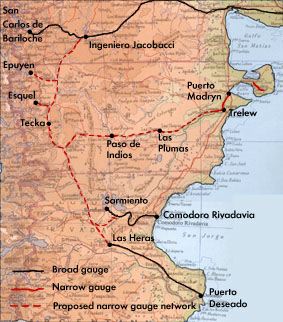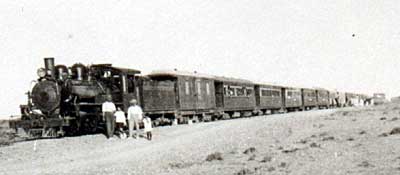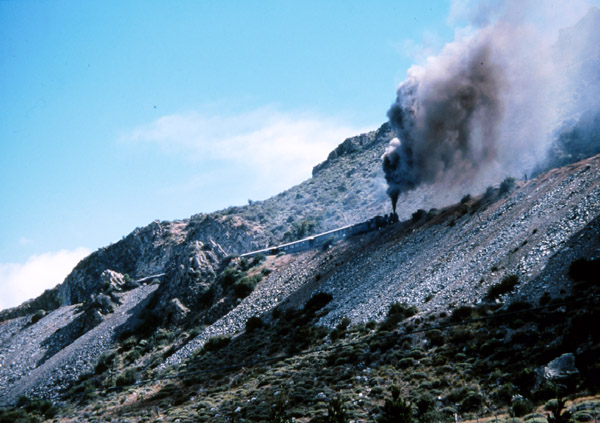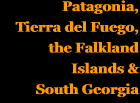|
1000 miles of narrow gauge?
New narrow gauge plans
After the end of the First World War, the plans were recast on a more modest basis, to link the newly-completed broad gauge lines by a pattern of narrow-gauge feeders. The FCCC became the centrepiece of these new proposals. A great deal seems to have happened relatively suddenly in 1922. The FC del Estado directors formed a committee in April to study the possibility of opening 75cm. lines. On the 16th August , the Argentine Congress approved plans for the purchase of the FCCC by the Ferrocarriles del Estado and on October 7th, by presidential decree works were able to begin. As the next pages show, a large number of locomotives and vehicles were also purchased during the first half of the year. The precise nature of the decision-making that year remains open to speculation, though the Administrator General of the state railways, Señor Beschtedt, was sacked in 1924, effectively for incompetence and corruption. His successor, Señor Perez, was extremely critical about some of the decisions that had been taken, as can be seen from a translation of his 1925 report on the progress in Patagonia (12) This is discussed further on the 1922 locomotives page.
 Initially the State Railways took a 12 month lease of the FCCC from 1st November 1922. They intended to complete outright purchase as soon as possible but their finances were in a catastrophic state for most of the 1920s and they only completed the purchase in 1936 (2). However, in 1922 they immediately set about reconstruction. It was proposed to convert the pre-existing FCCC line to 75cm. (approx 2' 6") gauge and to extend it to form the basis of a large network on that gauge, stretching from the Bariloche broad gauge line in the north down to the foreshortened lines from Comodoro Rivadavia and Puerto Deseado. The accompanying map shows one interpretation of the proposals, but as with the earlier broad gauge plans there seem to have been many different variations, from month to month almost, and only the routes actually constructed can be precisely defined. Initially the State Railways took a 12 month lease of the FCCC from 1st November 1922. They intended to complete outright purchase as soon as possible but their finances were in a catastrophic state for most of the 1920s and they only completed the purchase in 1936 (2). However, in 1922 they immediately set about reconstruction. It was proposed to convert the pre-existing FCCC line to 75cm. (approx 2' 6") gauge and to extend it to form the basis of a large network on that gauge, stretching from the Bariloche broad gauge line in the north down to the foreshortened lines from Comodoro Rivadavia and Puerto Deseado. The accompanying map shows one interpretation of the proposals, but as with the earlier broad gauge plans there seem to have been many different variations, from month to month almost, and only the routes actually constructed can be precisely defined.
Such a network would have comprised over 1000 miles (1600 km.) of naroow gauge, and would only have been rivalled by the Bosnia-Herzegovina lines, or possibly by the Moroccan 60cm. gauge systems. There were doubts expressed at an early stage, about the inadvisability of relying on such a narrow gauge over such a large area. These were eventually set out in the book La Patagonie y sus Problemes by General Jose Maria Sarobe (3) from which the outline of the map was taken. It should be noted that I have interpreted the sketch map in the book and have shown the railways following obvious valleys or other routeways. In particular the book shows a direct route from Paso de Indios west to Tecka. This would go straight over Monte Barroa so I have made the shortest sensible diversion to the south.
An excursion train on the regauged FC Central del Chubut, probably on the Rawson branch. The locomotive is one of the 25 Baldwin 2-8-2s purchased in 1922.

A sparsely populated area
An understanding of the proposals, of their rapid abandonment, and of the eventual closure of almost all the Patagonian public service railways, requires that we study the population of the area. These lines, broad or narrow, were not built to serve an existing population but to promote inward migration and the exploitation of new resources. In large part this did not happen, at least until the 1980s, by which time road transport was king.
An FCP analysis from the 1950s examines the traffic possibilities for each of the isolated lines. In passing it lists population figures for each settlement: the towns and villages along the extended FCCC route total up to 25,000 people along 160 miles (252 km.). The broad gauge lines fared even worse. As has been set out in the previous chapter, beyond the 30,000 people in Comodoro Rivadavia there were 18,500 spread along 125 miles 197km, and on the Puerto Deseado route there were only 7,000 people in total for a line length of 177 miles (283km.)!
Finally, the same document points out repeatedly that the three isolated lines relied on other companies' ships to link them and to provide a service northwards to the Federal Capital. In the circumstances the railways could not possibly compete with lorry transport, either on cost or reliability. Politicians and railway officials through the years have pleaded for a 'trans-Patagonian' railway down the coast. to link up the isolated tracks. This plea continues to be made even today, and is considered in more detail in the broad gauge chapter.
Locos & rolling stock
As suggested above, plans for the new network were probably prepared well before the actual takeover as the 25 Baldwin 2-8-2s delivered to the new line bear the date 'June 1922' on their worksplates (ie. two months before the takeover). However, there are one or two puzzles about the locomotives ordered for the line (see the section on the 1922 Locomotives). Enough equipment was purchased to make possible the relaying of the existing line on the new gauge as well as the construction of the new main line extension to Esquel (440miles, or 700km., from Puerto Madryn), the short branch to Rawson, and the rest of the proposed network. At least 81 locomotives were purchased, whilst 765 wagons and 100 coaches were built by a Belgian company. The initial invitations to tender had been for 50 locomotives, 100 baggage and passengers cars and 650 goods wagons (4). Other equipment included 200,000 rails from Thyssen, and a further 80,000 from d'Ougrée Marihayes (12). Materials were initially delivered to stockpiles at Puerto Madryn and San Antonio Oeste.
Incidentally the Baldwin Locomotives magazine for October 1922, reporting on the 2-8-2s built for Patagonia, records their destination as the 'Red Ferrocarriles Livianos de la Patagonia".
Extending the FCCC
An immediate start was made on the building of the new branch from Trelew to Rawson and Playa Union. This was completed in 1924. Construction of the main line extension from Dolavon to Esquel apparently began only in 1925. By 1928 work had reached Las Plumas (150 miles or 242 km. from Pto. Madryn), but there work was halted.
That further extension was expected for several years is shown by the line being referred to as the 'Línea a Colonia 16 de Octubre' in the 1940 working timetable book. Colonia 16 de Octubre is centred around the village now known as Trevelin, near Esquel in the more westerly Welsh area. However, it is clear from Señor Perez' 1925 report (12) that there had been a high level decision to concentrate efforts on providing access to the pre-cordillera from the north (ie by what became the Esquel line) rather than across the uninhabited wilderness west from the the FCCC.
Little trains in a big landscape. This shot on the Esquel line approaching Nahuel Pan gives the lie to thoughts of toy railways (5).

Southwards towards Esquel
At the same time, work began in the north, on the line from the not-yet-completed broad gauge to Bariloche south-westwards towards Esquel. This too ran into difficulties, and work was halted in 1928 or '29, perhaps influenced by the deepening worldwide recession (6). After a pause, work restarted on this line in 1932, but to a higher standard and on a completely revised route heading much further west towards El Maiten and Esquel. The line was opened in stages from 1936(?), and to its final terminus of Esquel by 1945. This line has its own page further on in this chapter.
Bitter criticism
As suggested above, the narrow gauge proposals met with some opposition. As the FCE financial situation worsened and the work slowed down, so criticism in Congress and the press became more heated. Eventually Doctor Beschtedt, the FCE Administrator, was forced to resign (in September 1924) on the grounds of maladministration.
The Review of the River Plate in early 1925 (7) quotes the daily newspaper La Prensa as bemoaning the way the Patagonian proposals have become so tied up in party politics. The stockpiles at Puerto Madryn and San Antonio are decribed as having cost $10,000,000m/n and as being sufficient to build 1000km of line and run it for eighty years! Mention of this "costly and wasteful outlay" was later reinforced by comments about the finances of the state railways "rusting away down south in Patagonia" (8). The FFCC del Estado were certainly almost bankrupt for much of the 1920s, and they had defaulted on payments to suppliers to such a degree as to prompt The Review of the River Plate to suggest that the debt was "casting a shadow on all the great purchasing departments of the state" by making Argentina seem less than credit-worthy (9).
Whilst there was no money available to restart work on the large scale needed for the original network, government was keen to see some of the spare equipment used up and the railways administration equally keen to diminish the focus of its embarrassment. Smaller schemes cropped up to use some of the 75cm gauge track, locos and rolling stock. Some of these are detailed below:
The Río Negro valley line and other offshoots of the 75cm. gauge
The first substantial user of some of this equipment was a line built a little further north, in Río Negro province, from General Vintter on the broad gauge near SAn Antonio north and north-west to Conesa and the town originally known as San Juan. This railway also has a page devoted to it in this chapter.
Several other railways eventually used track, engines or rolling stock from the Puerto Madryn and San Antonio stores. These included:
1. A pier construction line in Comodoro Rivadavia which eventually became a public railway to Rada Tilly.
2. The Lapachito to El Zapallar branch up north in the Chaco. It is out of our area but it is mentioned briefly in the last page of this chapter.
3. In 1947 a railway was proposed for Tierra del Fuego, to bring timber and wool from Tolhuin northwards for 100 miles or so to the port of Rio Grande. This too was to use up 75cm. gauge equipment from Puerto Madryn. It has been suggested that rails and maybe other materials were landed at Rio Grande's frigorifo muelle before a change of heart took place and the RFIEP/RFIRT, mentioned below, was built instead (10). See the last page for this line too.
4. Some track materials went to the Puerto Belgrano naval base for their 'strategic railway' out to gun positions on the coast. A paragraph on this line is also in the final page.
5. By far the largest later user of 75cm. gauge rails, engines and wagons, was the Ramal Ferro Industrial Eva Peron, later called the Ramal Ferro Industrial Río Turbio, a 160 mile coal line built in Santa Cruz province in the early 1950s. This line has a whole chapter devoted to it.
References:
1 Narrow Gauge Rails to Esquel, Keith Taylorson, Plateway Press, 23 Hanover St., Brighton, BN2 2ST, UK, 1999.
2 Law 11,869 of 28 August 1934 authorised the final purchase and payment of 1.95M gold pesos as a settlement of arrears of rent and interest since 1930. A liquidator for the company was appointed in December 1936, and the final meeting return was registered on 31 July 1947. Info from S. Damus.
3 La Patagonie y sus Problemes, General José Maria Sarobe, Buenos Aires 1934, 2nd. edition 1943.
4 Details of the tenders received are in Review of the River Plate, 3rd March 1922 pp531-35, 24 March 1922 pp723-5, and 18th August 1922.
5 Photo by Andy Kirkham, 1995.
6 Reported in various issues of the 'Estadistica de Ferrocarriles en Explotación', Info via S. Damus.
7 The Review of the River Plate 24 April 1925 p47. Buenos Aires.
8 Ibid. 25 Feb1927 p21, quoting La Prensa of Feb 21.
9 Ibid. 30 April 1926 p9.
10 Interview with Oscar Domingo Gutierrez in Río Grande, January 2001.
11 La Trochita. 2001 by Sergio Sepiurka & Jorge Miglioli, Grupo Abierto Comunicaciones. Buenos Aires.
12 The State Railways Patagonic Lines, a report by the Administrator General of the State Railways, Dr Enrique S. Perez, May 1925. Available as Appendix 16 to this chapter.
28-5-08
|
|








